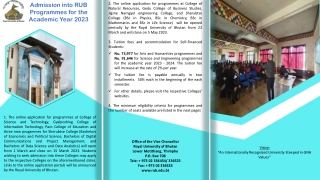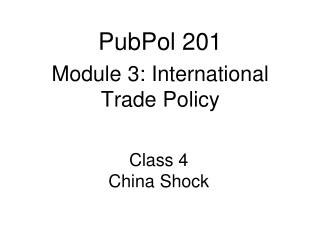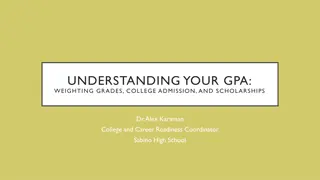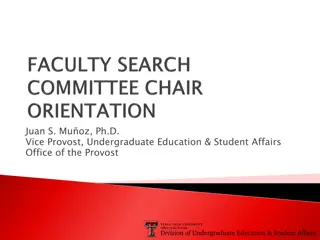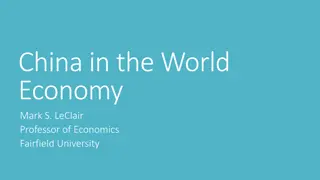Evolution of Affirmative Action Policies in College Admission in China
The historical development of affirmative action policies in college admissions in China is traced from the Republic Era to contemporary times. The policies have evolved from preferential treatment based on certain backgrounds to programs benefiting ethnic minorities and residents in underdeveloped regions. The impact of these policies on college entrance exams and the composition of college students over the years is highlighted.
Download Presentation

Please find below an Image/Link to download the presentation.
The content on the website is provided AS IS for your information and personal use only. It may not be sold, licensed, or shared on other websites without obtaining consent from the author. Download presentation by click this link. If you encounter any issues during the download, it is possible that the publisher has removed the file from their server.
E N D
Presentation Transcript
AFFIRMATIVE ACTION POLICIES IN COLLEGE ADMISSION IN CHINA TIAN FANGMENG (FREEMAN) MINZU UNIVERSITY OF CHINA SCHOOL OF ETHNOLOGY AND SOCIOLOGY 2023.2.8
Key points A sketch of affirmative action in China New programs in the past decade Problems and costs of affirmative action A compromised policy option
A paper in traditional Chinese Affirmative Action Policies in College Admission in China
National College Entrance Exam The National College Entrance Examination is a standardized college entrance exam held annually in China. It is required for entrance into almost all higher education institutions at the undergraduate level. The overall score of an examinee is the (weighted) sum of their subject scores. The admission criteria vary considerably by college, group and province.
Historical Sketch I In the Republic Era (1911-1949), China expanded its higher education sector, but most colleges did not take favorable admission policies or implement them extensively. Once taking the power, the communist government stipulated that college applicants with certain backgrounds could be preferably admitted and their proportions should reach certain level. The backgrounds included industrial workers, revolutionary soldiers, ethnic minorities, and overseas Chinese.
Historical Sketch II Between 1950 s and 1970 s, the Chinese government dramatically raised the share of college students from peasant and worker families. Their proportion among the freshmen increased from 27.9% in 1953 to 71.2% in 1965. The government lowered and even denied the education opportunities of applicants of non-proletariat origins, including those from families of landlords, merchants, capitalists, counterrevolutionaries, etc. During the Culture Revolution (1966-1976), even the national entrance examination was terminated for a decade.
Contemporary Admission Policies I After the Culture Revolution, favorable admission policies based on class were eliminated in the late 1970 s. The share of students from peasant and worker families decreased, particularly in the leading universities. In the 1980 s, China began to launch news college admission programs by both quota and preference measures. Beneficiaries of such programs include ethnic minorities and residents in underdeveloped regions, as well as those in well-developed first-tier cities.
Major Affirmative Action Programs in China Program Period Target population A quota system of national admission by province 1977 - now Residents in underdeveloped, border, first-tier cities A variety of programs targeting ethnic minority at national and local level 1980 s - now Ethnic minority in different provinces Admission Coordination Scheme for Supporting Central and Western Regions 2008 - now Residents in certain central and western regions National Admission Plan for Poverty Alleviation 2012 - now Residents in certain poor rural areas Miscellaneous programs 1980 s now, some terminated Chinese in HK, children of revolutionary martyrs, students with special talent
Contemporary Admission Policies II Affirmative action programs in China serve several social and political policy goals, such as maintaining political stability, reducing regional development gap, pushing regional prosperity of ethnic minority, and assisting national unity and unification. Examinees in Beijing and Shanghai could be admitted at lower criteria, partly because there are many more colleges in the two cities, and partly because the government intentionally did so to gain the political loyalty of local residents, which echoed the Keju institution in ancient China.
Contemporary Admission Policies III In the reform era, China has been implementing new affirmative action programs expansively and intensively. Consequentially, ethnic minority students represented 6.6% of national college students in 1998, compared with 4.2% in 1978. In the leading universities, those from poor rural areas roughly represented about 10% of the student body.
Contemporary Admission Policies IV Affirmative action programs in China are effective in reducing higher educational inequality and promoting campus diversity. Meanwhile, these programs have also led to considerable problems and costs, such as lowering admission criteria, mistargeting individual beneficiaries, and causing identity fraud.
Lowering Admission Criteria The admission criteria between Chinese provinces can be as large as 100 points (750 full). The score of an ethnic minority student can be leveled by 5-20 points additionally. As China is a country with the largest population in the world, a 10-point preference means the beneficiary would jump over thousands of examinees with higher scores to be admitted. The admission criteria gap might cause mismatch effect , because the beneficiaries often become underachievers in their colleges.
Mistargeting Beneficiaries Affirmative action policies intend to assist disadvantaged groups, but their true beneficiaries sometimes become those least need help. This is also the case in China. For example, students from poor provinces like Guizhou often have cadre background, while some ethnic minority students come from prosperous urban areas. Those truly disadvantaged individuals in China probably would not attend the national entrance exam, and drop from middle school at their early age.
Identity Fraud When China expanded its preference programs favoring ethnic minorities in the 1990 s, millions of Chinese changed their ethnic status. Many middle school students also changed their hukou status, so they would be qualified to attend national entrance exam in a province with lower admission criteria. Some rich people even send their kids abroad and obtained foreign citizenship, so they can attend Chinese top universities as foreigners .
Tradeoff between Costs and Benefits I Although China initiated market-oriented reform in the 1980 s, it still claims itself as a socialist country, and is committed to narrowing development gaps in order to achieve common prosperity . Affirmative action programs in China, particularly those implemented after 2012, can be viewed as a policy package for achieving new egalitarian goals. The question here is not whether affirmative action should be adopted in China, but how.
Tradeoff between Costs and Benefits II Higher education admission is an important pillar of meritocracy in every country, but academic criterion should not be the only standard of selection. Affirmative action programs in China aim to realize legitimate political and social goals, while they also bring severe costs and problems, which should be acknowledged by policymakers and experts. Considering both the effects and costs of the preferential admission policies, it s better view the issue as a tradeoff , instead of a solution .
A Compromised Policy Option I As a general observation, the more intense of an affirmative action program, such as large quota or strong preference, the more likely non-beneficiaries would complain it unfair, and more phenomenal the mismatch effects would be. Theoretically there should be middle point, where the benefits of affirmative action can balance its costs. I would suggest that a favor of at most 20 points for disadvantaged groups would be a better option for three reason.
A Compromised Policy Option II Affirmative action is supposed to be a temporary measure. If educational inequality can not be reduced by this measure, then it should be gradually diminished. Many Chinese official documents requires local governments to lower the admission moderately , and stipulates that at most 20 points in the same province for several times. According to a recent poll, the majority of professors and students at Chinese universities don t support a favor over 20 points, including ethnic minority students themselves.
Future Research Most Chinese experts of higher education attribute the academic performance gaps between different groups to a variety of environmental factors, but the real causes might be more complicated as migration and development are very dynamic in China . A biosocial model of human behavior might have high explanatory power with regard to the interaction between inheritance and environment. We should also organize more discussion on the political philosophy related to meritocracy and egalitarianism.
Thank you Q & A tianfm@muc.edu.cn




